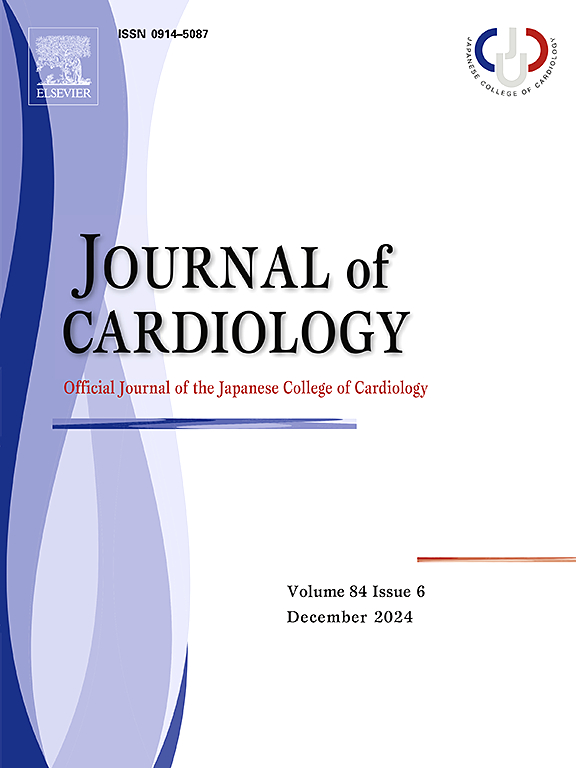使用 2017 ACC/AHA 指南进行血压分类与老年人心血管事件风险的关系。
IF 2.5
3区 医学
Q2 CARDIAC & CARDIOVASCULAR SYSTEMS
引用次数: 0
摘要
背景:在老年人中,一期高血压与心血管疾病(CVD)风险之间的关系尚未确定。此外,人们对降低血压是否有益于患有高血压 1 期的老年人知之甚少:这项队列研究分析了日本 DeSC 数据库中收集的全国数据,其中包括 476 654 名年龄≥60 岁的人。根据2017年ACC/AHA血压指南,患者被分为四组:血压正常、血压升高、1期高血压和2期高血压。主要结果是心血管疾病综合事件,包括心肌梗死、心绞痛、中风和心力衰竭:结果:在平均 3.1 年的随访期间,共记录了 53946 起心血管疾病综合事件。1期高血压与综合心血管疾病事件、心肌梗死、心绞痛、中风和心力衰竭的危险比分别为1.10(95 % CI,1.07-1.13)、1.16(95 % CI,1.03-1.31)、1.06(95 % CI,1.01-1.10)、1.13(95 % CI,1.08-1.18)和1.13(95 % CI,1.09-1.16)。收缩压在一年内下降≥ 5 mmHg 的患者中风风险低于高血压 1 期患者。在年龄≥75岁的人群中,1期高血压与综合心血管疾病事件之间的正相关性减弱:结论:1期高血压与老年人发生心血管事件的较高风险有关。2017年ACC/AHA血压指南可适用于老年人群;但是,这些指南是否适用于年龄≥75岁的老年人还需要进一步研究。本文章由计算机程序翻译,如有差异,请以英文原文为准。

BP classification using the 2017 ACC/AHA BP guidelines with risk of cardiovascular events in older individuals
Background
The association between stage 1 hypertension and the risk of cardiovascular disease (CVD) has not been established in older adults. Furthermore, little is known about whether lowering blood pressure (BP) is beneficial in older adults with stage 1 hypertension.
Methods
This cohort study analyzed nationwide data collected from the Japanese DeSC database, including 476,654 individuals aged ≥60 years. Individuals were categorized into four groups according to the 2017 ACC/AHA BP guidelines: normal BP, elevated BP, stage 1 hypertension, and stage 2 hypertension. The primary outcome was a composite CVD event, including myocardial infarction, angina pectoris, stroke, and heart failure.
Results
During a mean follow-up of 3.1 years, 53,946 composite CVD events were recorded. Hazard ratios of stage 1 hypertension for composite CVD events, myocardial infarction, angina pectoris, stroke, and heart failure were 1.10 (95 % CI, 1.07–1.13), 1.16 (95 % CI, 1.03–1.31), 1.06 (95 % CI, 1.01–1.10), 1.13 (95 % CI, 1.08–1.18), and 1.13 (95 % CI, 1.09–1.16), respectively. Individuals with a ≥5 mmHg decrease in systolic BP over one year had a lower risk of stroke among individuals with stage 1 hypertension. The positive association between stage 1 hypertension and composite CVD events was attenuated in individuals aged ≥75 years.
Conclusions
Stage 1 hypertension is associated with a higher risk of developing CVD events among older adults. The 2017 ACC/AHA BP guidelines could be applied to older populations; however, the applicability of these guidelines to older adults aged ≥75 years requires further investigations.
求助全文
通过发布文献求助,成功后即可免费获取论文全文。
去求助
来源期刊

Journal of cardiology
CARDIAC & CARDIOVASCULAR SYSTEMS-
CiteScore
4.90
自引率
8.00%
发文量
202
审稿时长
29 days
期刊介绍:
The official journal of the Japanese College of Cardiology is an international, English language, peer-reviewed journal publishing the latest findings in cardiovascular medicine. Journal of Cardiology (JC) aims to publish the highest-quality material covering original basic and clinical research on all aspects of cardiovascular disease. Topics covered include ischemic heart disease, cardiomyopathy, valvular heart disease, vascular disease, hypertension, arrhythmia, congenital heart disease, pharmacological and non-pharmacological treatment, new diagnostic techniques, and cardiovascular imaging. JC also publishes a selection of review articles, clinical trials, short communications, and important messages and letters to the editor.
 求助内容:
求助内容: 应助结果提醒方式:
应助结果提醒方式:


